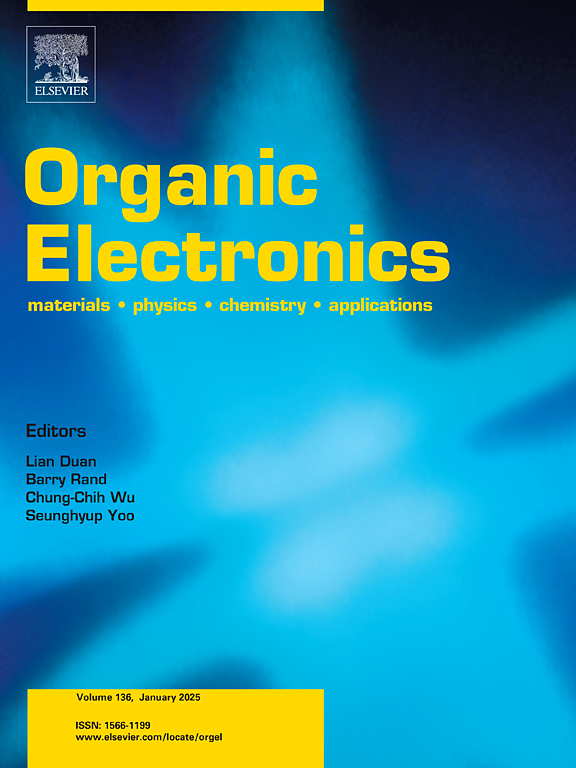通过水膜界面自组装揭示共轭/绝缘聚合物共混物垂直相分离在光电晶体管中的记忆效应
IF 2.6
4区 工程技术
Q3 MATERIALS SCIENCE, MULTIDISCIPLINARY
引用次数: 0
摘要
本研究利用聚(3-己基噻吩)(P3HT)和聚(1-芘甲基丙烯酸甲酯)(PPyMA)聚合物的共混物,通过气/液界面自组装实现垂直相分离。由于这些共混物的表面能不匹配,在共轭聚合物和绝缘聚合物之间形成了双层结构。混合薄膜应用于光晶体管存储器件,其中PPyMA作为光活性驻极体,P3HT作为半导体通道。通过对双转移方向水侧(正向结构)和空气侧(反向结构)的比较研究,发现PPyMA中芳香侧基的垂直相分离形态及其共轭关系与光记忆器件的光响应、记忆保持和耐用性密切相关。电学分析表明,采用前向转移(P3HT/PPyMA)制备的器件可以通过暴露于265 nm、310 nm、365 nm的紫外光和455nm的蓝光下实现照片写入,而通过栅极偏置进行电擦除,从而产生宽的记忆窗口(~ 48.7 V)。该器件在重复写入/擦除测量中也表现出稳定的记忆比,长期稳定性超过104 s。相反,用反向转移(PPyMA/P3HT)制作的器件,由于反向双层结构,需要空穴注入才能穿过绝缘的PPyMA层,并且空穴在垂直传输过程中可能与存储的电子重新结合,从而消除了存储机制。因此,设备不能有效地存储电荷以实现记忆保留。本研究通过空气/液体界面自组装实现了垂直相分离,揭示了光存储器件的光响应和电荷存储机制。本文章由计算机程序翻译,如有差异,请以英文原文为准。

Revealing the memory effect in phototransistors with vertical phase separation of conjugated/insulating polymer blends through film-on-water interface self-assembly
This study utilizes a blend of poly (3-hexylthiophene) (P3HT) and poly (1-pyrenemethyl methacrylate) (PPyMA) polymers to achieve vertical phase separation through air/liquid interface self-assembly. Due to the surface energy mismatch of these blends, a bilayer structure is formed between the conjugated and insulating polymers. The blended thin films are applied to phototransistor memory devices, with PPyMA as a photoactive electret and P3HT as a semiconductor channel. A comparative study of the two-transfer direction water side (forward structure) and air side (reverse structure) reveals that the vertical phase separation morphology of the aromatic side groups in PPyMA, along with its conjugation, is closely related to the photoresponse, memory retention, and durability of the photomemory devices. Electrical analysis shows that the device fabricated with the forward transfer (P3HT/PPyMA) can achieve photo writing through exposure to ultraviolet light at 265 nm, 310 nm, 365 nm, and blue light at 455 nm, while electrical erasure is performed via gate bias, resulting in a wide memory window (∼48.7 V). The device also exhibits a stable memory ratio in repeated write/erase measurements and long-term stability exceeding 104 s. In contrast, the device fabricated with the reverse transfer (PPyMA/P3HT), due to the reverse bilayer structure, required hole injection to pass through the insulating PPyMA layer, and holes may recombine with stored electrons during vertical transport, thereby dismissing the memory mechanism. As a result, the device cannot effectively store charges to achieve memory retention. This study demonstrates vertical phase separation through air/liquid interface self-assembly and reveals the photoresponse and charge storage mechanisms of photomemory devices.
求助全文
通过发布文献求助,成功后即可免费获取论文全文。
去求助
来源期刊

Organic Electronics
工程技术-材料科学:综合
CiteScore
6.60
自引率
6.20%
发文量
238
审稿时长
44 days
期刊介绍:
Organic Electronics is a journal whose primary interdisciplinary focus is on materials and phenomena related to organic devices such as light emitting diodes, thin film transistors, photovoltaic cells, sensors, memories, etc.
Papers suitable for publication in this journal cover such topics as photoconductive and electronic properties of organic materials, thin film structures and characterization in the context of organic devices, charge and exciton transport, organic electronic and optoelectronic devices.
 求助内容:
求助内容: 应助结果提醒方式:
应助结果提醒方式:


